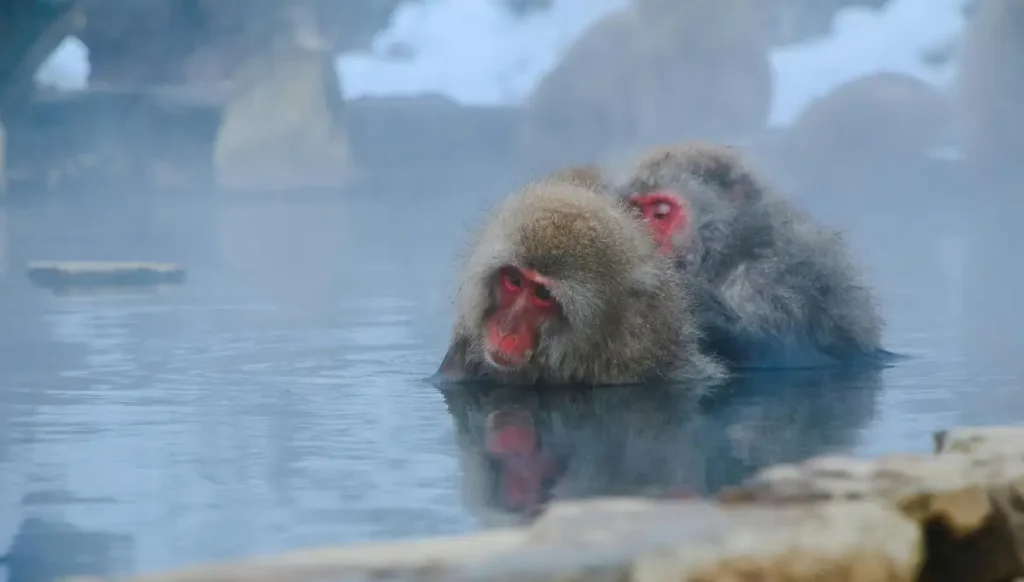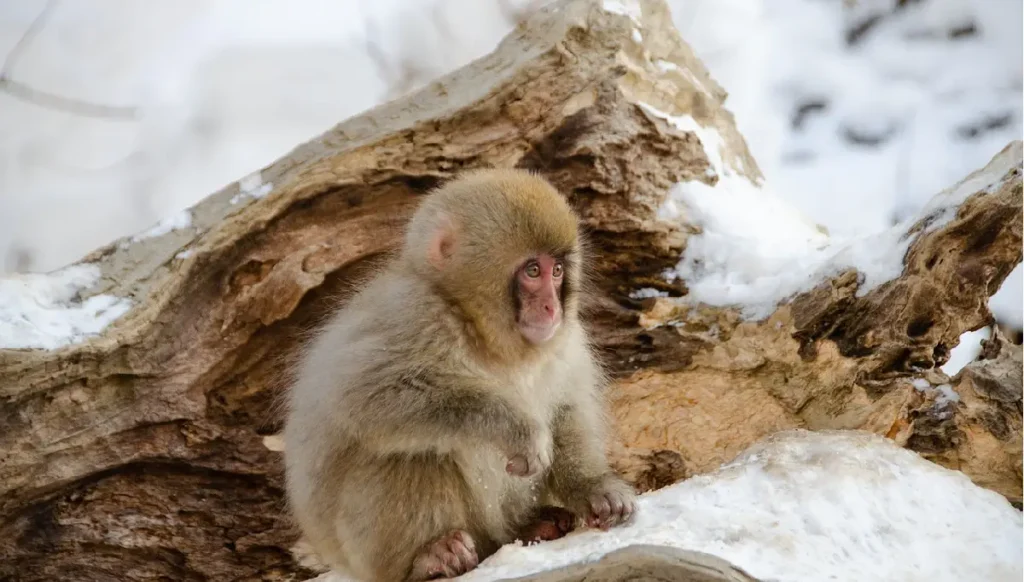Japan’s national animal is the Japanese macaque, also known as the snow monkey (Macaca fuscata). This distinctive primate is not only a symbol of Japanese wildlife but also deeply intertwined with Japanese culture and traditions. Here’s a detailed description of the Japanese macaque, its characteristics, and its cultural significance in Japan.
Characteristics of the Japanese Macaque

Appearance: The Japanese macaque is easily recognizable by its thick fur, which varies in color from brownish-gray to reddish-brown, and its prominent red face and buttocks. The species has a robust build, with a relatively short tail and strong limbs, making it well-adapted to various habitats.
Habitat: These monkeys are found across Japan, from the lowland forests to the snow-covered mountains of the Japanese Alps. They are notable for their adaptability, thriving in diverse environments ranging from subtropical forests to areas with heavy snowfall.
Behavior: Japanese macaques are highly social animals, living in large troops that can number from a few dozen to over a hundred individuals. They exhibit complex social structures and behaviors, including grooming, playing, and communicating through a range of vocalizations and facial expressions. One of their most remarkable behaviors is their use of hot springs, or snow monkey onsen, in the winter, where they soak in the thermal waters to stay warm.
Diet: Their diet is omnivorous, consisting of a variety of foods such as fruits, seeds, insects, and small animals. They are also known to forage for crops and occasionally raid agricultural fields, which can sometimes lead to conflicts with farmers.
Connection to Japanese Culture

Symbolism: The Japanese macaque holds significant cultural symbolism in Japan. Often depicted in traditional art and folklore, it represents various qualities such as wisdom, longevity, and fertility. The macaque’s presence in Japanese culture is also highlighted by its appearance in ancient Japanese paintings and sculptures.
Cultural Practices:
- Snow Monkey Onsen: The snow monkeys of Jigokudani Monkey Park are famous for their use of snow monkey onsen. This practice has become a symbol of Japanese onsen culture and is a popular attraction for both tourists and researchers. The image of macaques relaxing in steaming baths at this onsen with snow monkeys is emblematic of the Japanese love for hot springs.
- Folklore and Mythology: In Japanese folklore, monkeys are considered sacred and are believed to possess magical powers. They are featured in various myths and legends, often as messengers or protectors of mountains and temples.
- Shinto Shrines: The Japanese macaque is also associated with certain Shinto shrines and temples. Some shrines, like the Toshogu Shrine in Nikko, have macaque statues or motifs as symbols of protection and prosperity.
What is Japan’s Sacred Animal?
Japan’s sacred animal is the fox, particularly the kitsune. In Shinto belief, the fox is considered a messenger of the Shinto deity Inari, who is the god of agriculture, rice, and fertility. The kitsune is revered for its intelligence, magical abilities, and association with good fortune.
Characteristics of the Kitsune:
- Appearance: The kitsune is often depicted as a fox with multiple tails, ranging from one to nine. The more tails a kitsune has, the more powerful and venerable it is believed to be.
- Powers: Kitsune are believed to possess shapeshifting abilities, allowing them to transform into beautiful women or other beings. They are also associated with spiritual wisdom and mystical knowledge.
Cultural Significance:
- Inari Shrines: The kitsune is a common sight at Inari shrines, where statues of foxes are frequently found. These shrines are dedicated to Inari and are often marked by rows of red torii gates.
- Folklore: In Japanese folklore, the kitsune is featured in stories that highlight its magical powers and its role as a protector and guide. It is often portrayed as a benevolent guardian or a mischievous trickster.
Conclusion
The Japanese macaque is not just Japan’s national animal but also a vivid representation of the nation’s rich cultural heritage. From their unique behavior of soaking in hot springs to their deep-rooted symbolism in Japanese folklore, the Japanese macaque embodies both the natural and cultural essence of Japan. Additionally, the kitsune, Japan’s sacred animal, highlights the mystical and revered aspects of Japanese spiritual beliefs. Together, these animals offer a glimpse into the intricate relationship between Japan’s wildlife and its cultural traditions.


Leave a Reply